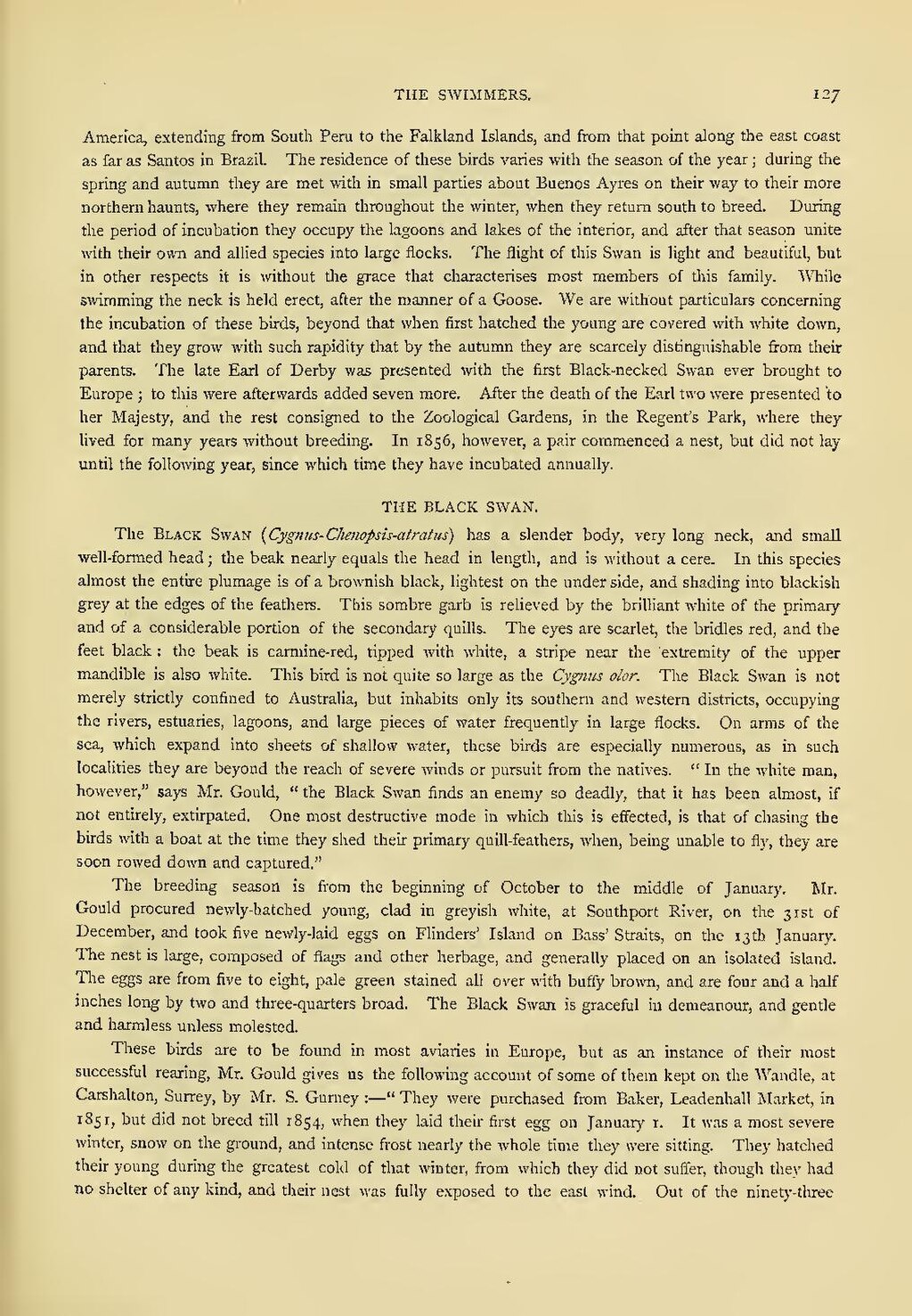America, extending from South Peru to the Falkland Islands, and from that point along the east coast as far as Santos in Brazil. The residence of these birds varies with the season of the year; during the spring and autumn they are met with in small parties about Buenos Ayres on their way to their more northern haunts, where they remain throughout the winter, when they return south to breed. During the period of incubation they occupy the lagoons and lakes of the interior, and after that season unite with their own and allied species into large flocks. The flight of this Swan is light and beautiful, but in other respects it is without the grace that characterises most members of this family. While swimming the neck is held erect, after the manner of a Goose. We are without particulars concerning the incubation of these birds, beyond that when first hatched the young are covered with white down, and that they grow with such rapidity that by the autumn they are scarcely distinguishable from their parents. The late Earl of Derby was presented with the first Black-necked Swan ever brought to Europe; to this were afterwards added seven more. After the death of the Earl two were presented to her Majesty, and the rest consigned to the Zoological Gardens, in the Regent's Park, where they lived for many years without breeding. In 1856, however, a pair commenced a nest, but did not lay until the following year, since which time they have incubated annually.
THE BLACK SWAN.
The Black Swan (Cygnus-Chenopsis-atratus) has a slender body, very long neck, and small well-formed head; the beak nearly equals the head in length, and is without a cere. In this species almost the entire plumage is of a brownish black, lightest on the under side, and shading into blackish grey at the edges of the feathers. This sombre garb is relieved by the brilliant white of the primary and of a considerable portion of the secondary quills. The eyes are scarlet, the bridles red, and the feet black: the beak is carmine-red, tipped with white, a stripe near the extremity of the upper mandible is also white. This bird is not quite so large as the Cygnus olor. The Black Swan is not merely strictly confined to Australia, but inhabits only its southern and western districts, occupying the rivers, estuaries, lagoons, and large pieces of water frequently in large flocks. On arms of the sea, which expand into sheets of shallow water, these birds are especially numerous, as in such localities they are beyond the reach of severe winds or pursuit from the natives. "In the white man, however," says Mr. Gould, "the Black Swan finds an enemy so deadly, that it has been almost, if not entirely, extirpated. One most destructive mode in which this is effected, is that of chasing the birds with a boat at the time they shed their primary quill-feathers, when, being unable to fly, they are soon rowed down and captured."
The breeding season is from the beginning of October to the middle of January. Mr. Gould procured newly-hatched young, clad in greyish white, at Southport River, on the 31st of December, and took five newly-laid eggs on Flinders' Island on Bass' Straits, on the 13th January. The nest is large, composed of flags and other herbage, and generally placed on an isolated island. The eggs are from five to eight, pale green stained all over with buffy brown, and are four and a half inches long by two and three-quarters broad. The Black Swan is graceful in demeanour, and gentle and harmless unless molested.
These birds are to be found in most aviaries in Europe, but as an instance of their most successful rearing, Mr. Gould gives us the following account of some of them kept on the Wandle, at Carshalton, Surrey, by Mr. S. Gurney:—"They were purchased from Baker, Leadenhall Market, in 1851, but did not breed till 1854, when they laid their first egg on January 1. It was a most severe winter, snow on the ground, and intense frost nearly the whole time they were sitting. They hatched their young during the greatest cold of that winter, from which they did not suffer, though they had no shelter of any kind, and their nest was fully exposed to the east wind. Out of the ninety-three
